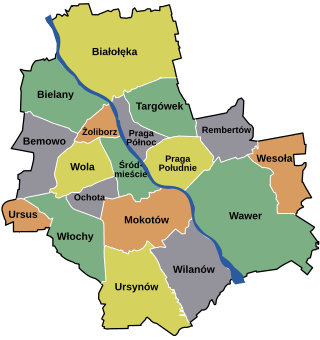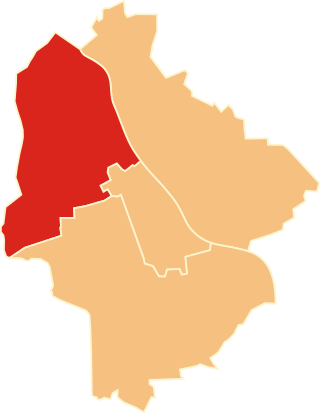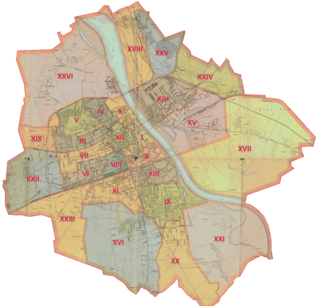
Warsaw is a city with powiat rights, and is further divided into 18 districts, auxiliary units which are legally integral parts of the city as an entity, but with some limited powers devolved to their own local governments.
Pavlovychi was a village in Ukraine. It is located in Chervonohrad Raion, Lviv Oblast. It was annexed by the Soviet Union in 1951 due to the Polish-Soviet territorial exchange and joined the Ukrainian Soviet Socialist Republic.

The District of Opolian Silesia, also designated as the 1st District, was a district that acted as an provisional administrative division of Poland, during the administration of the Provisional Government of the Republic of Poland in 1945, and the Provisional Government of National Unity from 1945 to 1946. It was centered around the area of the Upper Silesia. It was established as one of four provisional districts on 14 March 1945, and existed until 28 June 1946, when it was abolished and incorporated into the Silesian Voivodeship. The head of the district was the attorney-in-fact of the government, Aleksander Zawadzki.

The District of Western Pomerania, also designated as the 3rd District, was a district of Poland, during the administration of the Provisional Government of the Republic of Poland in 1945, and the Provisional Government of National Unity from 1945 to 1946. It was established as one of four districts on 14 March 1945, as one of the four districts created to administer the area known as the Recovered Territories, acquired by Poland from Nazi Germany, during, and in the aftermath of World War 2. It was formed within the boundaries of former German provinces of Brandenburg, and Pomerania, and consisted of the area of the Farther Pomerania and Lubusz Land. On 25 September 1945, its southern part was incorporated into the Poznań Voivodeship. It existed until 28 June 1946, when it was abolished and incorporated into the Szczecin Voivodeship.

The Lower Silesian District, also designated as the 2nd District, was a district that acted as an provisional administrative division of Poland, during the administration of the Provisional Government of the Republic of Poland in 1945, and the Provisional Government of National Unity from 1945 to 1946. It was centered around the area of the Lower Silesia. It was established as one of four provisional districts on 14 March 1945. On 25 September 1945, the territories near its northern border were incorporated into the Poznań Voivodeship. It existed until 28 June 1946, when it was abolished and replaced with the Wrocław Voivodeship. The head of the district was the attorney-in-fact Stanisław Piaskowski.

The Masurian District, also known as the District of East Prussia, and designated as the 4th District, was a district that acted as an provisional administrative division of Poland, during the administration of the Provisional Government of the Republic of Poland in 1945, and the Provisional Government of National Unity from 1945 to 1946. It was centered around the areas of Masuria, Powiśle and Warmia. It was established as one of four provisional districts on 14 March 1945. On 25 September 1945, areas near its western border were incorporated into the Gdańsk Voivodeship, while the areas near its eastern border, to the Białystok Voivodeship. It existed until 28 June 1946, when it was abolished and replaced with the Olsztyn Voivodeship. The head of the district was the attorney-in-fact Stanisław Piaskowski.

The Szczecin County was a county centered around the town of Police, that existed from 1946 to 1975. In 1946 it was a subdivision of the District of the Western Pomerania, and from 1946 to 1975, of the Szczecin Voivodeship. Its seat of government was located extrateritorially in the nearby city of Szczecin.

The Gdańsk Voivodeship was a voivodeship (province) with capital in Gdańsk, that was located in the region of Pomerelia. It existed from 1945 to 1975. Until 28 June 1945, it remained under the administration of the Provisional Government of the Republic of Poland, which then was replaced by the Provisional Government of National Unity. On, 19 February 1947, the provisional government was replaced by the Polish People's Republic. It was established on 7 April 1945, from the parts of the territories of the Pomeranian Voivodeship, and the Masurian District, Poland. The voivodeship ceased to exist on 31 May 1975, when it was partitioned by then-established voivodeships of Elbląg, Gdańsk, and Słupsk.

The North Warsaw County was a county within the city of Warsaw. It existed from 1928 to 1939, and from 1944 to 1960, as a county of Warsaw, that functioned as the voivodeship. From 1928 to 1939, it was under the administration of the Second Polish Republic, from 1944 to 1945, under the Provisional Government of the Republic of Poland, from 1945 to 1947, under the Provisional Government of National Unity, and from 1947 to 1960, under the Polish People's Republic.

The South Warsaw County was a county within the city of Warsaw. It existed from 1928 to 1939, and from 1944 to 1960, as a county of Warsaw, that functioned as the voivodeship. From 1928 to 1939, it was under the administration of the Second Polish Republic, from 1944 to 1945, under the Provisional Government of the Republic of Poland, from 1945 to 1947, under the Provisional Government of National Unity, and from 1947 to 1960, under the Polish People's Republic.

The Warsaw Praga County was a county of the Capital City of Warsaw, a voivodeship of the Second Polish Republic. It existed from 24 August 1928 to 1939.
The West Warsaw County was a county within the city of Warsaw. It existed from 1944 to 1960, as a county of Warsaw, an independent city, that functioned as a voivodeship. From 1944 to 1945, it was under the administration of the Provisional Government of the Republic of Poland, from 1945 to 1947, under the Provisional Government of National Unity, and from 1947 to 1960, under the Polish People's Republic.
The Warsaw Praga-Północ County was a county within the city of Warsaw. It existed from 1944 to 1960, as a county of Warsaw, an independent city, that functioned as a voivodeship. From 1944 to 1945, it was under the administration of the Provisional Government of the Republic of Poland, from 1945 to 1947, under the Provisional Government of National Unity, and from 1947 to 1960, under the Polish People's Republic.
The Warsaw Praga-Południe County was a county within the city of Warsaw. It existed from 1944 to 1960, as a county of Warsaw, an independent city, that functioned as a voivodeship. From 1944 to 1945, it was under the administration of the Provisional Government of the Republic of Poland, from 1945 to 1947, under the Provisional Government of National Unity, and from 1947 to 1960, under the Polish People's Republic.

The Chojna County was a county centered around the towns of Chojna and Dębno, that existed from 1945 to 1975. From 1945 to 1946, it was located in the District of the Western Pomerania, and from 1946 to 1975, in the Szczecin Voivodeship. Its seat was located in the towns of Dębno, and briefly in 1945, Chojna. In 1946, it had 19 537 inhabitants, and an area of 1374 km². Currently, its former area is under the administration of the counties of Gryfino and Myślibórz, located in West Pomeranian Voivodeship, Poland.
The Warsaw County was the county of the Masovian Voivodeship, Poland, consisting of the city of Warsaw, that existed from 1 January 1999 to 27 October 2002. It had an area of 536.5 km2.

The Warsaw Voivodeship was a voivodeship (province) of the Polish People's Republic, with capital in Warsaw, that was located in Masovia. It was established on 22 August 1944, and until 28 June 1945, it remained under the administration of the Provisional Government of the Republic of Poland, which then was replaced by the Provisional Government of National Unity. On, 19 February 1947, the provisional government was replaced by the Polish People's Republic. It existed until 31 May 1975, when it was partitioned into the voivodeships of Biała Podlaska, Białystok, Ciechanów, Lublin, Łomża, Ostrołęka, Płock, Radom, Siedlce, Skierniewice, and Warsaw Capital.

The Maritime County was a county centered around the Gdynia and Wejherowo, that existed from 1927 to 1939, and from 1945 to 1951. From 1927 to 1939, it was located in the Pomeranian Voivodeship, in the Second Polish Republic. In 1945, it was located in the Pomeranian Voivodeship, and from 1945 to 1951, it was located in the Gdańsk Voivodeship, which, in 1945 were under the administration of the Provisional Government of the Republic of Poland, from 1945 to 1947, under the administration of the Provisional Government of National Unity, and since 1947, under the administration of the Polish People's Republic. Until 1928, its seat was located in the city of Gdynia, and was since then moved to Wejherowo.

The Suppression of Wawrzyszew was an pacification operation during the Second World War, enacted by German forces on the population of the village of Wawrzyszew. It took place on 3 August 1944, during the Warsaw Uprising, and as part of it, 30 inhabitants of the village were killed, the buildings set on fire, and remaining population displaced.

The Militia Districts were a geographic-administrative division of the city of Warsaw during the World War I German occupation.












